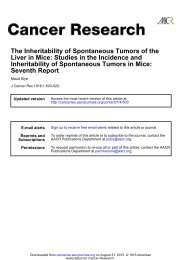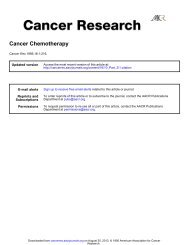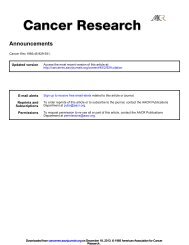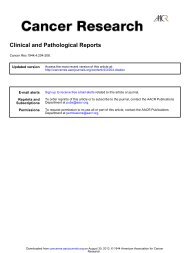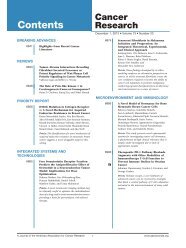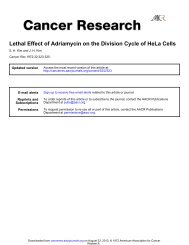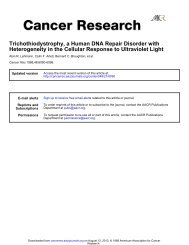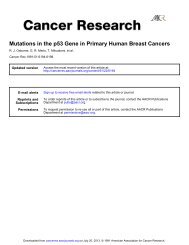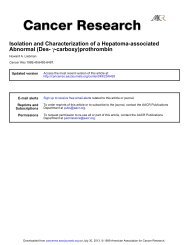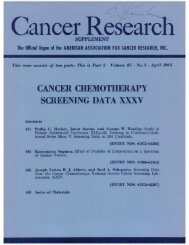Inhibition of Mitosis by Binding to the Colchicine ... - Cancer Research
Inhibition of Mitosis by Binding to the Colchicine ... - Cancer Research
Inhibition of Mitosis by Binding to the Colchicine ... - Cancer Research
Create successful ePaper yourself
Turn your PDF publications into a flip-book with our unique Google optimized e-Paper software.
Mechanism <strong>of</strong> Action <strong>of</strong> E7010, an Orally Active Sulfonamide<br />
Antitumor Agent: <strong>Inhibition</strong> <strong>of</strong> <strong>Mi<strong>to</strong>sis</strong> <strong>by</strong> <strong>Binding</strong> <strong>to</strong> <strong>the</strong><br />
<strong>Colchicine</strong> Site <strong>of</strong> Tubulin<br />
Kentaro Yoshimatsu, Atsumi Yamaguchi, Hiroshi Yoshino, et al.<br />
<strong>Cancer</strong> Res 1997;57:3208-3213.<br />
Updated version<br />
Access <strong>the</strong> most recent version <strong>of</strong> this article at:<br />
http://cancerres.aacrjournals.org/content/57/15/3208<br />
E-mail alerts Sign up <strong>to</strong> receive free email-alerts related <strong>to</strong> this article or journal.<br />
Reprints and<br />
Subscriptions<br />
Permissions<br />
To order reprints <strong>of</strong> this article or <strong>to</strong> subscribe <strong>to</strong> <strong>the</strong> journal, contact <strong>the</strong> AACR Publications<br />
Department at pubs@aacr.org.<br />
To request permission <strong>to</strong> re-use all or part <strong>of</strong> this article, contact <strong>the</strong> AACR Publications<br />
Department at permissions@aacr.org.<br />
Downloaded from<br />
cancerres.aacrjournals.org on August 10, 2013. © 1997 American Association for <strong>Cancer</strong><br />
<strong>Research</strong>.
ICANCERRESEARCH57, 3208-3213. August 1, 19971<br />
Mechanism <strong>of</strong> Action <strong>of</strong> E7010, an Orally Active Sulfonamide Antitumor Agent:<br />
<strong>Inhibition</strong> <strong>of</strong> <strong>Mi<strong>to</strong>sis</strong> <strong>by</strong> <strong>Binding</strong> <strong>to</strong> <strong>the</strong> <strong>Colchicine</strong> Site <strong>of</strong> Tubulin<br />
Kentaro Yoshimatsu,' AtSUmi Yamaguchi, Hiroshi Yoshino, Nozomu Koyanagi, and Kyosuke Ki<strong>to</strong>h<br />
Tsukuba <strong>Research</strong> Labora<strong>to</strong>ries, Eisai Co. Ltd., 1-3 Tokodai 5-chome, Tsukuba-shi, Ibaraki 300-26, Japan<br />
ABSTRACT<br />
E7010 (N-[2-[(4-hydroxyphenyl)amino]-3-pyridinyll-4-methoxybenze<br />
nesulfonamide), an orally active sulfonamide antitumor agent that is<br />
currently in a Phase I clinical trial, showed ra<strong>the</strong>r consistent growth<br />
inhibi<strong>to</strong>ry activities against a panel <strong>of</strong> 26 human tumor cell lines<br />
(IC@ 0.06-0.8 @ag/ml), in contrast<strong>to</strong> vlncristine(VCR;ICso 0.0002<br />
0.04 @.tg/ml), 5-fluorouracil (IC@ = 0.2—30 gag/mI), Adriamycin<br />
(IC50= 0.002-0.7 gag/ml),mi<strong>to</strong>mycinC (ICso 0.0073 @Lg/Ifll),<br />
arobin<strong>of</strong>uronoxylcy<strong>to</strong>sine (ICse 0.005 <strong>to</strong> >30 gLg/ml), camp<strong>to</strong><strong>the</strong>cin<br />
and tubulin-binding agent with different properties from those <strong>of</strong><br />
Taxol, VCR, or CLC.<br />
MATERIALS AND METHODS<br />
Drugs. E7010 and 14C-labeledE70l0 (specific activity, 56 mCi/mmol;<br />
phenyl-U-RING-'4C; Fig. 3B) were syn<strong>the</strong>sized at Tsukuba <strong>Research</strong> Labo<br />
1-@3-D- ra<strong>to</strong>ries, Eisai Co. Ltd. Reference compounds were obtained from <strong>the</strong> follow<br />
ing sources: VCR, vinblastine, CDDP, CPT, VP16, and melphalan were<br />
@ (ICso 0.®2@0.4 andcisplatin(ICso 0.520 @LgJ1fll). It caused obtained from Sigma (St. Louis, MO); 5-FU was obtained from Tokyo Kasei<br />
a dose-dependent increase in <strong>the</strong> percentage <strong>of</strong> mi<strong>to</strong>tic cells in parallel (Tokyo, Japan); ADM, MMC, CLC, POD, and MTX were obtained from<br />
with a decrease in cell proliferation, like VCR. It also showed a dose Wako Junyaku (Tokyo, Japan); and Ara-C (Cylocide) was obtained from<br />
dependent inhibition <strong>of</strong> tubulin polymerization, which correlated well Nippon Sinyaku (Kyo<strong>to</strong>, Japan). Taxol was obtained from <strong>the</strong> Drug Syn<strong>the</strong>sis<br />
with <strong>the</strong> cell growth-Inhibi<strong>to</strong>ry activity. ‘4C-labeledE7010 bound <strong>to</strong> pu and Chemstry Branch, Division <strong>of</strong> <strong>Cancer</strong> Treatment, National <strong>Cancer</strong> Insti<br />
rifled tubulin, and this binding was Inhibited <strong>by</strong> colchicine but not <strong>by</strong> tate. Trisnordolastatin was kindly provided <strong>by</strong> Dr. Shioiri (Nagoya City<br />
VCR. However,its bindingpropertieswere differentfrom those <strong>of</strong> col University, Nagoya, Japan). [3H]VCR was purchased from Amersham, and<br />
chicine, as well as those <strong>of</strong> VCR. E7010 was active against two kinds <strong>of</strong> [3HICLC was purchased from DuPont New England Nuclear.<br />
VCR-resistant P388 cell lines, one <strong>of</strong> which showed multidrug resistance<br />
due <strong>to</strong> <strong>the</strong> overexpression<strong>of</strong> P-glycoproteln(resistant<strong>to</strong> Taxol),and <strong>the</strong><br />
Cell Lines. P388 murine leukemia and MX-l were supplied <strong>by</strong> <strong>Cancer</strong><br />
Chemo<strong>the</strong>rapy Center, Japan Foundation for <strong>Cancer</strong> <strong>Research</strong> (Tokyo, Japan).<br />
o<strong>the</strong>rdidnotshowmultidrugresistance(sensitive<strong>to</strong> Taxol).Fur<strong>the</strong>rmore,<br />
four E7010-resistant P388 cell lines showed no cross-resistance <strong>to</strong> VCR, a<br />
VCR-resistant P388 cell line (P388/VCR) with overexpression <strong>of</strong> P-glycopro<br />
1cm(4)waskindlysupplied<strong>by</strong>Dr.M.Inaba(<strong>Cancer</strong>Chemo<strong>the</strong>rapy Center,<br />
different pattern <strong>of</strong> resistance <strong>to</strong> podophyllo<strong>to</strong>xin, and collateral sensitiv Japan Foundation for <strong>Cancer</strong> <strong>Research</strong>). H460, H520, H596, HCT-!16,<br />
ity <strong>to</strong> Taxol. Therefore, E7010 is a novel tubulin-binding agent that has a SW480, SW620, COLO2O5,DLD-!, HCF-l5, HT-29, MiApaca-Il, and HL-60<br />
wider antitumor spectrum than VCR and has different properties from were obtained from <strong>the</strong> American Type Culture Collection (Rockville, MD).<br />
those <strong>of</strong> VCR or Taxol.<br />
PC1, PC9, and MKN28 were obtained from <strong>the</strong> Immuno Biology Labora<strong>to</strong>ry<br />
(Gunma, Japan). A549, WiDr, LS!74T, COLO32ODM, ZR-75-l, CCRF<br />
INTRODUCTION<br />
CEM, and K562 were obtained from Dainippon Pharmaceutical Co., Ltd.<br />
(Osaka, Japan). PC1O,MKN45, and KATO-3 were obtained from <strong>the</strong> Japanese<br />
As part <strong>of</strong> <strong>the</strong> search for clinically effective antitumor drugs <strong>to</strong> treat <strong>Cancer</strong> <strong>Research</strong> Resources Bank (Tokyo, Japan). All cell lines were main<br />
refrac<strong>to</strong>ry solid tumors, we have screened a number <strong>of</strong> sulfonamides,<br />
because this class <strong>of</strong> compounds is well known <strong>to</strong> have a variety <strong>of</strong><br />
mined in RPMI 1640 containing 10% heat-inactivated fetal bovine serum,<br />
penicillin (100 units/nil), strep<strong>to</strong>mycin (100 @g/ml), 2-mercap<strong>to</strong>ethanol (50<br />
biological activities, such as antibacterial, insulin-releasing, carbonic<br />
anhydrase-inhibi<strong>to</strong>ry, and antithyroid activities (1). We found that<br />
E7010 showed a wide <strong>the</strong>rapeutic range <strong>of</strong> antitumor activity in <strong>the</strong><br />
colon 38 carcinoma model (2). It inhibited <strong>the</strong> growth <strong>of</strong> colon 38<br />
cells inoculated s.c. <strong>by</strong> 60—99%when administered at doses <strong>of</strong> 25—<br />
@LM), and sodium pyruvate (1 mM).<br />
MTT Assay. Exponentially growing cells were plated in<strong>to</strong> 96-well tissue<br />
culture plates and precultured for 1 day. Various concentrations <strong>of</strong> test com<br />
pounds were added, and <strong>the</strong> cells were incubated for an additional 3 days. The<br />
antiproliferative activity was measured <strong>by</strong> MU assay, and <strong>the</strong> IC50 values<br />
were determined.<br />
100 mg/kg daily for 8 days (3). It was also active against mouse Mi<strong>to</strong>tic Index. P388 cells were treated with <strong>the</strong> indicated concentrations <strong>of</strong><br />
tumors (s.c. inoculated M5076 fibrosarcoma, s.c. inoculated Lewis E70l0 or VCR for 12 h. Viable cell numbers were determined <strong>by</strong> <strong>the</strong> trypan<br />
lung carcinoma, and i.p. inoculated P388 leukemia), a rat tumor (s.c. blue dye exclusion method, and cells were treated with 0.075 M KC1, fixed<br />
inoculated SST-2 mammary carcinoma), and human xenografts (LC<br />
376, LC-6, and LX- 1 lung cancer; H-8l , H-! 11, SC-2, and SC-6<br />
gastric cancer; H-143, COLO32ODM, and WiDr colon cancer; and<br />
H-31 and MX-l breast cancer) upon oral administration (3). More<br />
over, E70l0 was effective against VCR2-resistant, CDDP-resistant,<br />
and 5-Ri-resistant P388 cells in vivo (3).<br />
The present study was designed <strong>to</strong> elucidate <strong>the</strong> mechanism <strong>of</strong><br />
(3:1, methanol:acetic acid), and stained with 0.1% crystal violet. The mi<strong>to</strong>tic<br />
index was determined <strong>by</strong> counting at least 500 cells.<br />
Microtubule Polymerization Assay. Microtubule protein from bovine<br />
brain was prepared <strong>by</strong> two cycles <strong>of</strong> assembly and disassembly in assembly<br />
buffer [0.1 M morpholinoethanesulfonate, 1 mM EGTA, and 0.5 mM MgCl2<br />
(pH 6.8); Ref. 5]. Protein concentration was determined using <strong>the</strong> Bio-Rad<br />
protein assay kit. The reaction mixture contained 2 mg/mI mcrotubule protein<br />
and <strong>the</strong> half-log step concentrations (0.89, 2.7, 8.9, and 27 ,.@M)<strong>of</strong> E70l0 in<br />
action <strong>of</strong> E7010, and we report here that E70l0 is a novel antimi<strong>to</strong>tic assembly buffer containing 1 mM GTP. Microtubule polymerization was<br />
initiated <strong>by</strong> warming <strong>the</strong> sample from 0°C<strong>to</strong> 37°Cin a 1-mi cuvette, and<br />
Received 3/4/97; accepted 6/2/97.<br />
turbidity (@A350) was recorded during <strong>the</strong> indicated time intervals with a<br />
The costs <strong>of</strong> publication <strong>of</strong> this article were defrayed in part <strong>by</strong> <strong>the</strong> payment <strong>of</strong> page spectropho<strong>to</strong>meter (Fig. 3A). In <strong>the</strong> study <strong>of</strong> <strong>the</strong> relationship between antipro<br />
charges. This article must <strong>the</strong>refore be here<strong>by</strong> marked advertisement in accordance with<br />
18 U.S.C. Section 1734 solely <strong>to</strong> indicate this fact.<br />
I To whom requests for reprints should be addressed. Phone: 81-298-47-5749; Fax:<br />
81-298-47-2037.<br />
2 The abbreviations used are: VCR, vincristine; 5-FU, S-fluorouracil; ADM, Adria<br />
liferative activity and microtubule polymerization-inhibi<strong>to</strong>ry activity (Fig. 3B),<br />
<strong>the</strong> wells <strong>of</strong> 96-well plates contained 1 mg/ml microtubule protein and log step<br />
concentrations <strong>of</strong> E70l0 derivatives. The plates were incubated at 37°C,and<br />
<strong>the</strong> turbidity was recorded with a mcroplate reader (ThermoMax; Molecular<br />
mycin; MMC, mi<strong>to</strong>mycin C; Ara-C, l-@-o-arabin<strong>of</strong>uranoxylcy<strong>to</strong>sine; CPT, camp<strong>to</strong><strong>the</strong>cin;<br />
CDDP,cisplatin;CLC, colchicine;POD, podophyllo<strong>to</strong>xin;NOC,nocodazole;MTX,<br />
methotrexate; VP16, e<strong>to</strong>poside; MNNG, N-methyl-N'-nitro-N-mtrosoguanidine; MU,<br />
3-(4,5-dimethylthiazol-2-yl)-2,5-diphenyltetrazolium bromide; MDR, multidrug-resistant;<br />
Devices) for 20 mn kinetically. The turbidity at 20 mm (<strong>the</strong> polymerization in<br />
<strong>the</strong> control reached a plateau level) was plotted on a linear scale versus <strong>the</strong><br />
concentration <strong>of</strong> <strong>the</strong> test compound on a log scale, and <strong>the</strong> concentration<br />
CQS, chioroquinoxaline sulfonamide.<br />
causing a 50% inhibition <strong>of</strong> polymerization was determined.<br />
3208<br />
Downloaded from<br />
cancerres.aacrjournals.org on August 10, 2013. © 1997 American Association for <strong>Cancer</strong><br />
<strong>Research</strong>.
@<br />
@<br />
.@)<br />
‘3<br />
0<br />
j<br />
@iO@OO@ @-@(OOU)<br />
@ .1.<br />
c@<br />
MECHANISM OF ACFION OF E70l0<br />
Fig. 1. The effects <strong>of</strong> E70l0 and antitumor drugs on <strong>the</strong> proliferation <strong>of</strong> 26 human<br />
tumor cell lines. Cells were treated with various concentrations <strong>of</strong> <strong>the</strong> compounds for 3<br />
days.The antiproliferativeactivitywas determined<strong>by</strong> MU assay,and IC50for each<br />
compoundwascalculated.A:•,E7010;0, VCR;i@,5-Ri; D, ADM.B:0, MMC; @,<br />
Ara-C; 0, CPT; X, CDDP. The cell lines used were non-small cell lung cancers PC1, PC9,<br />
PC1O, A549, H520, H460, and H596; colon cancers WiDr, LS174T, COLO32ODM,<br />
HCT-l 16, SW620, C0L0205, DLD-l, HCF-15, SW480, and HT29; s<strong>to</strong>mach cancers<br />
MKN28, MKN45, and KATO3; pancreatic cancer MiApaca-Il; breast cancers MX-l and<br />
@-75-l;and leukemias CCRF-CEM, 1(562, and HL-60.<br />
3209<br />
E7010-resistant clones 0.5r-D, l.Or-H, and 4.Or-M were cloned, respectively.<br />
E7010-resistant cell line 0.6r-8 was isolated <strong>by</strong> a four-step selection. MNNG<br />
treatment was used at each step, and <strong>the</strong> dose <strong>of</strong> E7010 at each step was 0.1,<br />
0.2, 0.3, and 0.6 @g/ml.After <strong>the</strong> four-step selection, 0.6r-8 was cloned.<br />
RESULTS<br />
The Effects <strong>of</strong> E7010 and Antitumor Drugs on <strong>the</strong> Proliferation<br />
<strong>of</strong> Human Tumor Cell Lines. The antiproliferative activities <strong>of</strong><br />
E7010 and various clinically used antitumor drugs were tested against<br />
a panel <strong>of</strong> 26 human tumor cell lines (7 lung cancers, 10 colon<br />
cancers, 3 s<strong>to</strong>mach cancers, 1 pancreatic cancer, 2 breast cancers, and<br />
3 leukemias) <strong>by</strong> MU assay. E70l0 showed a dose-dependent and<br />
broad-spectrum antiproliferative activity (Fig. 1). The IC50 values <strong>of</strong><br />
E7010 on various human tumors were ra<strong>the</strong>r similar (0.06—0.8 p.g/<br />
ml), in contrast <strong>to</strong> those <strong>of</strong> VCR (0.0002—0.04 @.tg/ml),5-FU (0.2—30<br />
j@g/ml), ADM (0.002-0.7 @tg/ml),MMC (0.007-3 @g/ml),Ara-C<br />
(0.005->30 @.Lg/ml),CPT (0.002-0.4 @@g/ml), and CDDP (0.5-20<br />
@@g/ml).<br />
The Effect <strong>of</strong> E7010 on Cell Cycle Progression. Antitumor<br />
agents are known <strong>to</strong> arrest cell cycle progression in S phase, 02, or M<br />
phase (10, 11). Therefore, <strong>the</strong> effect <strong>of</strong> E7010 on <strong>the</strong> cell cycle<br />
progression <strong>of</strong> P388 cells was examined <strong>by</strong> flow cy<strong>to</strong>metry, and<br />
E70l0 was found <strong>to</strong> arrest P388 cells in <strong>the</strong> G2-M phase. Next, we<br />
examined whe<strong>the</strong>r E7010 increases <strong>the</strong> percentage <strong>of</strong> mi<strong>to</strong>tic cells,<br />
because agents that arrest cells in M phase, such as VCR, increase <strong>the</strong><br />
mi<strong>to</strong>tic index, but agents that cause G2 arrest, such as VP16, decrease<br />
it. E7010 caused a dose-dependent increase in <strong>the</strong> mi<strong>to</strong>tic index, like<br />
VCR (Fig. 2), and <strong>the</strong> rise in mi<strong>to</strong>tic index was well correlated with<br />
<strong>the</strong> decrease in cell proliferation. We also observed an increase in <strong>the</strong><br />
mi<strong>to</strong>tic index <strong>of</strong> s.c. implanted M5076 tumor at 18—24h after <strong>the</strong> oral<br />
administration <strong>of</strong> E7010 (data not shown).<br />
The Effects <strong>of</strong> E7010 and Its Derivatives on Microtubule<br />
Polymerization. The results described above and <strong>the</strong> immun<strong>of</strong>luo<br />
rescence observation that E70l0 caused <strong>the</strong> disappearance <strong>of</strong> cy<strong>to</strong><br />
plasmic microtubules in colon 38 cells (data not shown) led us <strong>to</strong><br />
examine E7010 for effects on microtubule polymerization. E70l0<br />
caused dose-dependent inhibition <strong>of</strong> microtubule polymerization (Fig<br />
ure 3A). Fur<strong>the</strong>rmore, a linear relationship between <strong>the</strong> antiprolifera<br />
<strong>Binding</strong> Assay. Tubulin was purified from microtubule protein on a phos<br />
60<br />
8<br />
phocellulose column (6). The binding assay was performed using <strong>the</strong> DEAE<br />
cellulose filter method <strong>of</strong> Borisy (7). The reaction mixture (0.2 ml) contained<br />
tubulin and ‘4C-labeled E70l0 (2 aiM;0.0224 pCi/reaction), [3H]VCR (0.25<br />
50<br />
,.tM; 0.05 MCi/reaction), or [3H]CLC (1 ,.LM;0.1 pCi/reaction) in assembly<br />
buffer. The reaction was s<strong>to</strong>pped <strong>by</strong> rapid cooling <strong>to</strong> 4°C, and <strong>the</strong>n <strong>the</strong> mixture<br />
40<br />
was diluted with 5 ml <strong>of</strong>O.lX assembly buffer, filtered through a stack <strong>of</strong> three<br />
Whatman DE81 ion exchange paper discs using a BRANDEL cell harvester<br />
@<br />
(Biomedical <strong>Research</strong> and Development Labora<strong>to</strong>ries, MD), and washed with<br />
10 ml <strong>of</strong> 0.lX assembly buffer.<br />
Isolation <strong>of</strong>Non-MDR VCR-reslstant P388. VCR-resistant cell lines that<br />
did not show <strong>the</strong> MDR phenotype were isolated from MNNG (Aldrich)-treated<br />
P388 cells <strong>by</strong> selection with both increasing doses <strong>of</strong> VCR (0.5, 1.0, 2.0, and<br />
4.0 ng/ml) and 10 @Mverapamil <strong>to</strong> avoid <strong>the</strong> development <strong>of</strong> <strong>the</strong> mdr<br />
phenotype (8, 9). When <strong>the</strong> relative resistance <strong>of</strong> VCR-resistant cells <strong>to</strong> VCR<br />
reached about 10 times, <strong>the</strong> VCR-resistant clone P3881V4—4 was cloned in<br />
x<br />
S<br />
.u<br />
.E<br />
U<br />
0<br />
30<br />
20<br />
10<br />
1@<br />
VCR and verapamil-containing medium using <strong>the</strong> limiting dilution method.<br />
The relative resistance was determined in <strong>the</strong> absence <strong>of</strong> verapamil <strong>by</strong> MU<br />
0<br />
.001 .01 .1 1 10<br />
assay.<br />
Isolation <strong>of</strong> E7010-resistant P388. E70l0-resistant cell lines 0.5r-D,<br />
Concentration (@sg/mI)<br />
1.Or-H,and 4.Or-M were isolated <strong>by</strong> MNNG-treated P388 cells <strong>by</strong> selection Fig. 2. The effects <strong>of</strong> E70l0 and VCR on proliferation and <strong>the</strong> mi<strong>to</strong>tic index. P388 cells<br />
with increasing doses <strong>of</strong> E70l0 (0.1, 0.2, 0.3, 0.4, 0.5, 0.7, 0.8, 0.9, 1.0, 1.2,<br />
2.0, 3.0, and 4.0 p@g/ml).When <strong>the</strong> relative resistance <strong>of</strong> E7010-resistant cells<br />
were treated with <strong>the</strong> indicated concentrations <strong>of</strong> E70l0 (•, ) or VCR (0, []) for 12 h.<br />
The number <strong>of</strong> viable cells (, El) and <strong>the</strong> mi<strong>to</strong>tic index (•,0) were determined as<br />
described in “Materials and Methods.â€Values represent <strong>the</strong> mean ±SE (bars) <strong>of</strong> three<br />
<strong>to</strong> E70l0 reached about 5 (13 weeks), 10 (18 weeks), and 40 times (21 weeks), independent experiments.<br />
Downloaded from<br />
cancerres.aacrjournals.org on August 10, 2013. © 1997 American Association for <strong>Cancer</strong><br />
<strong>Research</strong>.
0.3<br />
@ J//,,,,,,,—,—.--..,—------'—--———--.<br />
Control<br />
0<br />
A<br />
i<br />
B<br />
@-U,<br />
00<br />
C<br />
.2a)<br />
.0@<br />
C<br />
0.2<br />
0.1<br />
0.0<br />
0<br />
4<br />
3<br />
5 10 15 20 25<br />
Time (mm)<br />
l4@<br />
R@H@Q<br />
@1fl2<br />
14<br />
MECHANISM OF ACTION OF E7010<br />
0.89 sM<br />
2.7 @tM<br />
8.9 sM<br />
27 pM<br />
R= 0.92<br />
R2=H<br />
R3=OH A<br />
2 3 4 5<br />
InhibitIon <strong>of</strong> tubulin polymerization<br />
log [1C50(nM)]<br />
6<br />
Fig. 3. The effect <strong>of</strong> E70l0 on microtubule polymerization (A) and <strong>the</strong> correlation<br />
between antiproliferative activities and inhibi<strong>to</strong>ry activities against microtubule poly<br />
merization in E7010 derivatives (B). A, <strong>the</strong> reaction mixture contained 2 mg/mI micro<br />
tubule protein and <strong>the</strong> indicated concentration <strong>of</strong> E70l0 in assembly buffer. Microtubule<br />
polymerization was recorded as described in “Materials and Methods.â€B, in this study, <strong>the</strong><br />
effects <strong>of</strong> E7010 derivatives on microtubule polymerization were determined using 1<br />
mg/mI microtubule protein. Each point, <strong>the</strong> antiproliferative activity and antipolymeriza<br />
tion activity <strong>of</strong> an E7010 derivative. 1, R' CH3O, R2 = OH, and R3 = H; 2,<br />
R' = CH3O,R2= H,andR3= H;3, R' = CH1O,R2= H,andR3= F;4, R' CH3O,<br />
R2 = CH@,and R3 = OH; 5, R' = C2H5, R2 = H, and R3 = H; 6, R' = CH3O, R2 = H,<br />
and R3 = Cl; 7, R' CH1O, R2 = H, and R3 = OH; 8, R' CH3, R2 = H, and R3 = H;<br />
9, R' = C2H50, R2 = H, and R3 = H; 10, R' = CH3O, R2 = H, and R3 = C2H5O; 11,<br />
R@= CH1O,R2= H,andR3= phenyl;12,R' = CH1O,R2= H,andR3= COOC2H5;<br />
13, R' = CH3O, R2 = H, and R3 = CH3; 14, R' = CH3O, R2 = H, and R3 = CH3O;<br />
15, R' = CH3O, R2 = H, and R3 = SCH3; 16, R' = CH3CO, R2 = H, and R3 = H; 17,<br />
R' = CN,R2= H,andR3= H; 18,R' = NO2,R2= H,andR3= H; 19:R' = CH3O,<br />
R2 CH3O,andR3= CH3O.<br />
tive activity <strong>of</strong> a compound and its activity <strong>to</strong> inhibit microtubule<br />
polymerization was found for various E70l0 derivatives that had been<br />
syn<strong>the</strong>sized during <strong>the</strong> development <strong>of</strong> E70l0 (Fig. 3B). These results<br />
strongly suggest that <strong>the</strong> inhibition <strong>of</strong> microtubule polymerization is<br />
responsible for <strong>the</strong> antiproliferative action <strong>of</strong> E7010.<br />
The <strong>Binding</strong> <strong>of</strong> ‘4C-labeledE7010 <strong>to</strong> Tubulin. Compounds that<br />
arrest <strong>the</strong> cells in mi<strong>to</strong>sis and inhibit tubulin polymerization are<br />
known <strong>to</strong> bind <strong>to</strong> tubulin at <strong>the</strong> Vinca site or <strong>the</strong> CLC site (12—15).<br />
The binding <strong>of</strong> E7010 <strong>to</strong> tubulin was examined and compared with<br />
<strong>the</strong> binding <strong>of</strong> VCR and CLC, which are typical tubulin-binding<br />
agents (Fig. 4). The binding <strong>of</strong> E70l0 <strong>to</strong> tubulin was rapid and did<br />
not show temperature dependence. On <strong>the</strong> o<strong>the</strong>r hand, <strong>the</strong> binding<br />
<strong>of</strong> VCR was slow at 4°C,whereas CLC could not bind <strong>to</strong> tubulin<br />
at 4°Cas reported previously (12), and its binding was slow even<br />
at 37°C.<br />
3210<br />
<strong>Inhibition</strong> <strong>of</strong> ‘4C-labeledE7010, [3H]VCR, or [3H]CLC <strong>Binding</strong><br />
<strong>to</strong> Tubulin. To determine <strong>the</strong> binding site <strong>of</strong> E7010, inhibition <strong>of</strong> <strong>the</strong><br />
binding <strong>of</strong> ‘4C-labeledE70l0, [3H]VCR, or [3H]CLC <strong>to</strong> tubulin <strong>by</strong><br />
each unlabeled compound was examined. The binding <strong>of</strong> E70l0 <strong>to</strong><br />
tubulin was inhibited <strong>by</strong> CLC and enhanced <strong>by</strong> VCR (Fig. 5A). The<br />
binding <strong>of</strong> CLC was inhibited <strong>by</strong> E7010 and was also enhanced <strong>by</strong><br />
VCR (Fig. SB). The enhancement <strong>of</strong> <strong>the</strong> binding <strong>by</strong> VCR was caused<br />
<strong>by</strong> stabilization <strong>of</strong> <strong>the</strong> CLC-binding activity <strong>of</strong> tubulin (12, 16). The<br />
binding <strong>of</strong> VCR was not inhibited <strong>by</strong> E7010 or CLC (Fig. SC).<br />
Lineweaver-Burk analysis demonstrated that E7010 is a competitive<br />
inhibi<strong>to</strong>r <strong>of</strong> <strong>the</strong> binding <strong>of</strong> CLC and binds at <strong>the</strong> CLC site on tubulin<br />
(Fig. SD). The K1value for E70l0 <strong>of</strong> [3H]CLC was 3.3 @M(Fig. SD),<br />
and <strong>the</strong> K1 values for CLC, POD, and NOC, reported <strong>to</strong> bind at <strong>the</strong><br />
CLC site, were 2.7, 0.94, and 2.3 @M, respectively (data not shown).<br />
Cross-Resistance in VCR-resistant P388 Cells. Antimi<strong>to</strong>tic<br />
drugs that are widely used in cancer chemo<strong>the</strong>rapy, such as VCR,<br />
vinblastine, and Taxol, are good substrates for transport <strong>by</strong> P-glyco<br />
protein (classical MDR phenotype; Refs. 17—19).Moreover, o<strong>the</strong>r<br />
types <strong>of</strong> resistance <strong>to</strong> Vinca alkaloids have been reported (20—22),and<br />
we isolated VCR-resistant cells (P388/V4—4) that did not show <strong>the</strong><br />
classical MDR phenotype. Therefore, <strong>the</strong> effects <strong>of</strong> VCR, Taxol,<br />
ADM, CLC, and E70!0 on two MDR P388 cells (P388IVCR and<br />
P388/V0.256) and P3881V4—4cells were examined. The results are<br />
summarized in Table 1. P388/VCR and P388N0.256 cells, which<br />
overexpress P-glycoprotein, were significantly resistant <strong>to</strong> VCR,<br />
Taxol, CLC, and ADM but were sensitive <strong>to</strong> E7010. P3881V4—4cells,<br />
0<br />
E<br />
0.<br />
•0<br />
C<br />
0<br />
B<br />
0<br />
E<br />
0.<br />
•0<br />
C<br />
0<br />
0 30 60 90 120<br />
Time (mm)<br />
Fig. 4. The binding <strong>of</strong> ‘4C-labeledE70l0, [3H]VCR, and [3H]CLC <strong>to</strong> tubulin at 4°C<br />
and 37°C.Purified tubulin (0.45 mg/ml) was incubated with ‘4C-labeledE70l0 (•),<br />
[3H]VCR (0), or [3H]CLC (@) at 4°Cor 37°Cfor <strong>the</strong> time indicated. The binding <strong>to</strong><br />
tubulin was determined <strong>by</strong> <strong>the</strong> DEAE-cellulose filter method as described in “Materials<br />
and Methodsâ€and expressed as <strong>the</strong> mean for duplicate samples in a single experiment,<br />
which was repeated with similar results.<br />
Downloaded from<br />
cancerres.aacrjournals.org on August 10, 2013. © 1997 American Association for <strong>Cancer</strong><br />
<strong>Research</strong>.
Fig. 5. A comparison <strong>of</strong> <strong>the</strong> effects <strong>of</strong> E7010, CLC, and VCR on <strong>the</strong><br />
binding <strong>of</strong> ‘4C-labeledEbb, [3HICLC, and [3H]VCR <strong>to</strong> tubulin.<br />
Microtubule protein (0.4 mg/mI) was incubated with ‘4C-labeled E70l0<br />
(A),[3HICLC(B andD) or [3H]VCR(C)and<strong>the</strong> indicatedconcentra<br />
tions <strong>of</strong> unlabeled compounds for 2 h at 37°C.A, B, and C: •,E70l0;<br />
& CLC;0, VCR.In <strong>the</strong> Lineweaver-Burkanalysis(D),<strong>the</strong>following<br />
concentrations <strong>of</strong> [3H]CLC were used: 0.56, 0.83, 1.25, 2, 4, and 8 @sM.<br />
The binding was determined<strong>by</strong> <strong>the</strong> DEAE-cellulose filter methodas<br />
described in “Materials and Methods.â€Points, <strong>the</strong> mean for duplicate<br />
samples in a single experiment, which was repeated with similar results.<br />
MECHANISMOF ACI1ON OF E70l0<br />
0<br />
1@<br />
•1<br />
C<br />
0<br />
U<br />
which were isolated <strong>by</strong> exposure <strong>to</strong> VCR in <strong>the</strong> presence <strong>of</strong> verapamil,<br />
showed cross-resistance <strong>to</strong> vinblastine, vindesine, and trisnordolasta<br />
tin (a dolastatin analogue; Ref. 23) with resistance fac<strong>to</strong>rs <strong>of</strong> 4.7, 9.4,<br />
and 8.7, respectively, but <strong>the</strong>y had a collateral sensitivity <strong>to</strong> Taxol.<br />
P388/V4—4 cells were sensitive <strong>to</strong> E7010 and slightly resistant <strong>to</strong><br />
CLC.<br />
Cross-Resistance in E7010-resistant P388 Cell Lines. For <strong>the</strong><br />
clinical application <strong>of</strong> a new drug, understanding <strong>the</strong> mechanisms <strong>by</strong><br />
which resistance is developed is important. Therefore, we isolated<br />
four E7010-resistant cell lines and examined <strong>the</strong> sensitivity <strong>of</strong> E70l0resistant<br />
cell lines <strong>to</strong> clinically used antitumor drugs (VP16, 5-FU,<br />
CDDP, ADM, MTX, MMC, Ara-C, and melphalan; Fig. 6A) and<br />
antimi<strong>to</strong>tic agents (VCR, Taxol, CLC, NOC, and POD; Fig. 6B).<br />
None <strong>of</strong> E7010-resistant cell lines (0.6r-8, 0.5r-D, l.Or-H, and 4.Or-M)<br />
showed cross-resistance <strong>to</strong> any <strong>of</strong> <strong>the</strong> antitumor drugs <strong>of</strong> which <strong>the</strong><br />
target is not tubulin. On clinically used antimi<strong>to</strong>tic drugs, E70l0resistant<br />
cell lines exhibited no significant resistance <strong>to</strong> VCR but had<br />
increased sensitivity <strong>to</strong> Taxol. Among antimi<strong>to</strong>tic agents that bind <strong>to</strong><br />
<strong>the</strong> CLC site, NOC showed a similar pattern <strong>of</strong> resistance across <strong>the</strong><br />
spectrum <strong>of</strong> E70l0-resistant cell lines (resistance fac<strong>to</strong>r, 4.Or<br />
M 1.Or-H > 0.5r-D 0.6r-8). On <strong>the</strong> o<strong>the</strong>r hand, POD exhibited<br />
a different pattern <strong>of</strong> resistance (resistance fac<strong>to</strong>r, O.5r-D and l.Or<br />
H > 0.6r-8 and 4.Or-M). The pattern <strong>of</strong> resistance <strong>to</strong> CLC was similar<br />
<strong>to</strong> that <strong>of</strong> POD, although <strong>the</strong> resistance <strong>to</strong> CLC was minimal.<br />
•0<br />
C<br />
0<br />
.0<br />
0<br />
0<br />
p..<br />
Lu<br />
a<br />
0<br />
I-<br />
C<br />
0<br />
U<br />
0<br />
•0<br />
C<br />
0<br />
.0<br />
0<br />
> I<br />
C')<br />
@10@@ io6 io@ i@-@ io@ io6 io@ io@<br />
Concentration (M) Concentration (M)<br />
3211<br />
1o6 io@ io@<br />
Concentration (M)<br />
DISCUSSION<br />
-1 0 1<br />
1/Coichicine (1/pM)<br />
E70l0 was found <strong>by</strong> screening a number <strong>of</strong> sulfonamides with<br />
widely different chemical structures (2) and shows a broad spectrum<br />
<strong>of</strong> activity against mouse and human tumors (3). In a Phase I study <strong>of</strong><br />
E70l0 using a single-dose schedule, some responses were observed<br />
(24), and a 5-day continuous administration study is in progress. We<br />
have demonstrated here that E7010 is an antimi<strong>to</strong>tic agent, and <strong>the</strong><br />
target <strong>of</strong> its antiproliferative action is tubulin. CQS was reported <strong>to</strong><br />
have antiproliferative activity in vitro (25, 26), but <strong>the</strong> mechanism <strong>of</strong><br />
its action has not yet been elucidated. Therefore, we examined <strong>the</strong><br />
effect <strong>of</strong> CQS on cell cycle progression and tubulin polymerization.<br />
CQS did not arrest P388 cells in <strong>the</strong> G2-M phase and did not affect<br />
tubulin polymerization. Therefore, E70l0 seems <strong>to</strong> be a unique sul<br />
fonamide antitumor agent.<br />
Most <strong>of</strong> <strong>the</strong> tumor cell lines tested were almost equally sensitive <strong>to</strong><br />
E7010 (IC50 = 0.06—0.8 @sg/m1).This is consistent with <strong>the</strong> idea that<br />
<strong>the</strong> target <strong>of</strong> E7010 is tubulin, because microtubules in <strong>the</strong> mi<strong>to</strong>tic<br />
spindle are important for cell proliferation <strong>of</strong> all cells. In contrast, a<br />
wider range <strong>of</strong> IC50 values (0.002—0.04 p.g/ml) was observed with<br />
VCR. This might be due <strong>to</strong> <strong>the</strong> differential drug accumulation <strong>of</strong> VCR<br />
among <strong>the</strong>se tumor cells, which express P-glycoprotein <strong>to</strong> various<br />
extents. Indeed, HCT-15 and DLD-l, which were sensitive <strong>to</strong> E70l0<br />
(IC50 values <strong>of</strong> 0.08 and 0.14 p@g/ml,respectively) but very insensitive<br />
Downloaded from<br />
cancerres.aacrjournals.org on August 10, 2013. © 1997 American Association for <strong>Cancer</strong><br />
<strong>Research</strong>.<br />
2
,<br />
linesP388<br />
Table 1 The effects <strong>of</strong> VCR, Taxol, ADM, CLC, and E7010 on three VCR-resistant P388 cell<br />
cells and VCR-resistant P388 cell lines were treated with various concentrations <strong>of</strong> <strong>the</strong> compounds for 3 days. Antiproliferative activity was determined as indicated in<br />
“Materialsand Methods,â€and IC50 for each compound was calculated. Resistance fac<strong>to</strong>rs were calculated line.Resistance as IC50 for <strong>the</strong> resistant cell line: IC50 for <strong>the</strong> sensitive cell<br />
fac<strong>to</strong>rCell<br />
ADMP388/VCR line VCR Taxol E7010 CLC<br />
11.0 ±2.4'@ 6.3 ±0.9 1.2 ±0.2 — —<br />
P388N@,56 82.8 ±7.7 16.9 ±0.3 1.5 ±0.3 64.5 29.9 ±2.9<br />
0.08a P388/V4-4 8.4 ±0.7 0.18 ±0.05 1.3 ±0.2 2.7 ±0.2 0.58 ±<br />
Values represent<strong>the</strong> mean ±SE.<br />
<strong>to</strong> VCR, were reported <strong>to</strong> express P-glycoprotein and <strong>to</strong> show differ<br />
ential sensitivity <strong>to</strong> non-MDR versus MDR drugs (27). These obser<br />
vations are consistent with <strong>the</strong> finding that P388IVCR and P388/<br />
V0.256 were resistant <strong>to</strong> VCR but sensitive <strong>to</strong> E7010. The patterns <strong>of</strong><br />
antiproliferative activity against tumor cell lines except HCT-l5 and<br />
DLD-l were similar for VCR and E7010, although <strong>the</strong> ranges <strong>of</strong> IC50<br />
values were different.<br />
To examine <strong>the</strong> mechanism <strong>of</strong> action <strong>of</strong> E70l0, we first examined<br />
<strong>the</strong> effect on cell cycle progression, because this is related <strong>to</strong> <strong>the</strong><br />
mechanism <strong>of</strong> action (10, 11). Antimetabolites, such as MTX and<br />
Ara-C, cause cells <strong>to</strong> accumulate in <strong>the</strong> S phase. Topoisomerase<br />
inhibi<strong>to</strong>rs, VP16 and CPT, ADM, and MMC inhibit cell cycle pro<br />
gression in <strong>the</strong> 02 phase. Vinca alkaloids and Taxol arrest cells in <strong>the</strong><br />
M phase. By flow cy<strong>to</strong>metric analysis, we found that E70l0 accumu<br />
lated P388 cells in G2-M phase. E70l0 caused dose-dependent in<br />
creases in <strong>the</strong> mi<strong>to</strong>tic index in parallel with an inhibition <strong>of</strong> cell<br />
proliferation, like VCR.<br />
Because <strong>the</strong> antimi<strong>to</strong>tic effects <strong>of</strong> antimi<strong>to</strong>tic agents may be medi<br />
ated <strong>by</strong> disruption (VCR) or stabilization (Taxol) <strong>of</strong> microtubules in<br />
mi<strong>to</strong>tic spindles, <strong>the</strong> effects <strong>of</strong> E70l0 on microtubule structure in<br />
colon 38 cells were examined, and E7010 was shown <strong>to</strong> cause <strong>the</strong><br />
disappearance <strong>of</strong> cy<strong>to</strong>plasmic microtubules and mi<strong>to</strong>tic spindles (data<br />
not shown). Therefore, <strong>the</strong> effects <strong>of</strong> E7010 and E70l0 derivatives on<br />
microtubule assembly in a cell-free system were examined and corn<br />
pared with <strong>the</strong> growth-inhibi<strong>to</strong>ry activities. These experiments clearly<br />
demonstrated that <strong>the</strong> growth-inhibi<strong>to</strong>ry activity <strong>of</strong> E70l0 is caused<br />
<strong>by</strong> <strong>the</strong> inhibition <strong>of</strong> rnicrotubule assembly. Next, we examined<br />
whe<strong>the</strong>r E70l0 can bind <strong>to</strong> tubulin and compared <strong>the</strong> binding prop<br />
erties <strong>of</strong> E70l0 with those <strong>of</strong> VCR and CLC, although <strong>the</strong> structure <strong>of</strong><br />
E70l0 is quite different from those <strong>of</strong> <strong>the</strong> known tubulin binders,<br />
Fig. 6. Effects <strong>of</strong> antitumor agents and antimi<strong>to</strong>tic agents on E7OIO<br />
resistant P388 cell lines. P388 cells and E7OIO-resistant cell lines<br />
(0.6r-8, 0.5r-D, I Or-H, and 4.Or-M) were treated with various concen<br />
trations <strong>of</strong> <strong>the</strong> compounds for 3 days. Antiproliferative activity was<br />
determined as indicated in “Materialsand Methods,â€and IC,0 for each<br />
compound was calculated. Resistant fac<strong>to</strong>rs were calculated as IC50 for<br />
<strong>the</strong> resistant cell line:IC@0 for <strong>the</strong> sensitive cell line and shown graph<br />
ically as <strong>the</strong> mean value ±SE (bars; n = 3—10).<br />
MECHANISM OF ACtiON OF E7010<br />
L-PAM<br />
Ara-C<br />
MMC<br />
which bind <strong>to</strong> <strong>the</strong> CLC site or Vinca site on tubulin, such as CLC,<br />
NOC, Vinca alkaloids, rhizoxin, halichondrin, and so on. We found<br />
that E7010 binds <strong>to</strong> purified tubulin and that <strong>the</strong> binding site is <strong>the</strong><br />
CLC site, not <strong>the</strong> Vinca site, although <strong>the</strong> binding properties <strong>of</strong> E7010<br />
<strong>to</strong> tubulin were quite different from those <strong>of</strong> CLC. Therefore, E7010<br />
is quite distinct in its action from clinically used Vinca alkaloids or<br />
Taxol. The preliminary structure-activity study (Fig. 3B) reveals that<br />
<strong>the</strong> addition <strong>of</strong> methoxyl groups <strong>to</strong> <strong>the</strong> lower phenyl ring decreases <strong>the</strong><br />
activity (compounds 2, 14, and 19), which is intriguing in relation <strong>to</strong><br />
<strong>the</strong> structural fac<strong>to</strong>rs <strong>of</strong> o<strong>the</strong>r CLC site ligands such as CLC, and<br />
suggests that <strong>the</strong> ligand recognition on tubulin may be different<br />
between E7010 and CLC.<br />
The antimi<strong>to</strong>tic drugs, Vinca alkaloids and Taxol, are key drugs in<br />
cancer chemo<strong>the</strong>rapy, but drug resistance mediated <strong>by</strong> P-glycoprotein<br />
limits <strong>the</strong>ir usefulness against MDR tumors that have acquired resist<br />
ance in <strong>the</strong> course <strong>of</strong> chemo<strong>the</strong>rapy or naturally (17—19).In this study<br />
and in <strong>the</strong> previous one (3), we found that MDR cells selected <strong>by</strong><br />
exposure <strong>to</strong> VCR did not show cross-resistance <strong>to</strong> E7010. In <strong>the</strong> in<br />
vitro tumor panel study, E7010 seemed <strong>to</strong> be effective against natu<br />
rally resistant MDR cell lines such as HCT15, DLD-1, and<br />
OVCAR-4. There was also no cross-resistance with o<strong>the</strong>r MDR cell<br />
lines (KB 8—5,KB C-!, and KB C-2; data not shown). Because o<strong>the</strong>r<br />
types <strong>of</strong> drug resistance <strong>to</strong> VinCa alkaloids have been reported (20—<br />
22), we selected VCR-resistant P388/V4—4 cells, which did not show<br />
<strong>the</strong> classical MDR phenotype, <strong>by</strong> exposure <strong>to</strong> VCR and verapamil.<br />
Interestingly, P388/V4—4 cells showed resistance <strong>to</strong> Vinca alkaloids<br />
(VCR, vinblastine, and vindesine) and trisnordolastatin, an analogue<br />
<strong>of</strong> dolastatin 10 that binds <strong>to</strong> <strong>the</strong> Vinca site on tubulin (13) but had<br />
collateral sensitivity <strong>to</strong> Taxol. Surprisingly, P3881V4—4cells were not<br />
cross-resistant <strong>to</strong> E70l0. Fur<strong>the</strong>rmore, <strong>to</strong> clarify <strong>the</strong> resistance <strong>to</strong><br />
III<br />
d A<br />
U<br />
III 4.Or-M<br />
J.4 U 1.Or-H<br />
0 O.5r-D<br />
0 O.6r-8<br />
@ t I I I I I t I I I t I I I I I I I I<br />
MDC<br />
ADM<br />
CDDP<br />
5-FU<br />
VP16<br />
E7010<br />
p<br />
0.1 1 10<br />
Resistance fac<strong>to</strong>r<br />
3212<br />
NOC<br />
POD<br />
CLC<br />
Taxoi<br />
VCR<br />
E7010<br />
llllllllllllllllllP<br />
1nhT@.I<br />
@-I El 4.Or-M<br />
U 1.Or-H<br />
0 O.5r-D<br />
@l 0 O.6r-8<br />
100 0.1 1 10 100<br />
Resistance fac<strong>to</strong>r<br />
Downloaded from<br />
cancerres.aacrjournals.org on August 10, 2013. © 1997 American Association for <strong>Cancer</strong><br />
<strong>Research</strong>.<br />
:Ji<br />
l1lll1IIIllllllIllIll@'i<br />
W//@
E7010, four E70l0-resistant P388 cell lines were selected <strong>by</strong> exposure<br />
<strong>to</strong> E7010. E7010-resistant P388 cell lines were not cross-resistant <strong>to</strong><br />
VCR, but collateral sensitivity <strong>to</strong> Taxol was observed. The pattern <strong>of</strong><br />
<strong>the</strong> cross-resistance <strong>to</strong> tubulin binders that bind at <strong>the</strong> CLC binding<br />
site was very interesting. The pattern <strong>of</strong> <strong>the</strong> cross-resistance <strong>to</strong> NOC<br />
across <strong>the</strong> spectrum <strong>of</strong> four E70l0-resistant P388 cell lines was<br />
similar <strong>to</strong> that <strong>of</strong> E70l0, but <strong>the</strong> pattern <strong>of</strong> <strong>the</strong> cross-resistance <strong>to</strong> POD<br />
was quite different. The pattern <strong>of</strong>cross-resistance <strong>to</strong> CLC was similar<br />
<strong>to</strong> that <strong>of</strong> POD, although <strong>the</strong> resistance <strong>to</strong> CLC was minimum. These<br />
differences in <strong>the</strong> resistance pattern seem <strong>to</strong> be consistent with <strong>the</strong><br />
differences <strong>of</strong> <strong>the</strong> binding properties (binding site, temperature de<br />
pendency, rate <strong>of</strong> binding, and reversibility <strong>of</strong> binding) among tubulin<br />
binders. These suggest <strong>the</strong> involvement <strong>of</strong> alterations <strong>of</strong> <strong>the</strong> target,<br />
tubulin itself or <strong>the</strong> polymerization state <strong>of</strong> tubulin, that specifically<br />
affect <strong>the</strong> binding <strong>of</strong> <strong>the</strong> E70l0-type agent <strong>to</strong> tubulin in E70l0resistant<br />
cell lines, because <strong>the</strong> accumulation <strong>of</strong> 14C-labeled E70l0<br />
was similar in sensitive P388 cells and in E70l0-resistant cell lines<br />
(data not shown). CDDP-, 5-FU-, VP16-, and CPT-resistant cell lines<br />
also lacked cross-resistance <strong>to</strong> E70l0 (data not shown).<br />
Few CLC site binding agents are active in in vivo solid tumor models,<br />
although many compounds have been reported <strong>to</strong> bind <strong>to</strong> <strong>the</strong> CLC site on<br />
tubulin, such as CLC analogues (28), steganacin (29), POD analogues<br />
(30),combrestatin analogues (31),benzimidazole derivatives (32),1,2hydropyrido[3,4-b]pyrazine<br />
derivatives (33), 2-styrylquinazolin-4(3H)one<br />
derivatives (34), 2,3@ihydro-2-(aiyl)4(lfI)-quinazolinone deriva<br />
tives (35), and curacin A (36). We have shown here that E70l0 is a<br />
unique antimi<strong>to</strong>tic agent with a broad spectrum <strong>of</strong>antitumor activity. This<br />
drug is considered <strong>to</strong> be a candidate for clinical use, ei<strong>the</strong>r alone or in<br />
combination chemo<strong>the</strong>rapy.<br />
REFERENCES<br />
MECHANISM OF ACTION OF E7010<br />
I. Maren, T. H. Relations between structure and biological<br />
Annu. Rev. Pharmacol. Toxicol., 16: 309—327,1976.<br />
activity <strong>of</strong> sulfonamides.<br />
2. Yoshino, H., Ueda, N., Niijima, J., Sugumi, J., Kotake, Y., Okada, T., Koyanagi, N.,<br />
Asada, M., Yoshimatsu, K., and Ki<strong>to</strong>h, K. Novel sulfonamides as potential, system<br />
ically active antitumor agents. J. Med. Chem., 35: 2496—2497, 1992.<br />
3. Koyanagi, N., Nagasu, T., Fujita, F., Watanabe, T., Tsukahara, K., Funahashi, Y.,<br />
Fujita, M., Taguchi, T., Yoshino, H., and Ki<strong>to</strong>h, K. In viva tumor growth inhibition<br />
produced <strong>by</strong> a novel sulfonamide, E7O1O.against rodent and human tumors. <strong>Cancer</strong><br />
Res.,54: 1702—1706, 1994.<br />
4. Shinoda, H., Inaba, M., and Tsuruo, T. In viva circumvention <strong>of</strong> vincristine resistance<br />
in mice with P388 leukemia<br />
1722—1726, 1989.<br />
using a novel compound, AHC-52. <strong>Cancer</strong> Res., 49:<br />
5. Shelanski, M. L., Gaskin, F., and Can<strong>to</strong>r, C. R. Microtubule assembly in <strong>the</strong> absence<br />
<strong>of</strong> added nucleotides. Proc. Natl. Aced. Sci. USA, 70: 765—768,1973.<br />
6. Williams, R. C., Jr., and Detrich, H. M., 111.Separation <strong>of</strong> tubulin from microtubule<br />
associated proteins on phosphocellulose: accompanying alterations in concentrations<br />
<strong>of</strong> buffer components. Biochemistry, 18: 2499—2503, 1979.<br />
7. Borisy, 0. 0. A rapid method for quantitative determination <strong>of</strong> microtubule protein<br />
using DEAE-cellulose filters. Anal. Biochem.. 50: 373—385,1972.<br />
8. Chen, Y-N., Mickley, L. A., Schwartz, A. M., Ac<strong>to</strong>n, E. M., Hwang, J., and Fojo.<br />
A. T. Characterization<strong>of</strong> Adriamycin-resistant humanbreastcancercells which<br />
display overexpression <strong>of</strong> a novel resistance-related membrane protein. J. Biol.<br />
Chem., 265: 10073—10080,1990.<br />
9. Futscher,B. W., Foley,N. E., Gleason-Guzman,M. C., Meltzer,P. S., Sullivan,<br />
D. M.. and Dal<strong>to</strong>n, W. S. Verapamil suppresses <strong>the</strong> emergence <strong>of</strong> P-glycoprotein<br />
mediated multidrug resistance. lot. J. <strong>Cancer</strong>, 66: 520—525, 1996.<br />
10. Charcosset, J-Y. Effects <strong>of</strong> antineoplastic agents on <strong>the</strong> cell cycle progression. Biol.<br />
Cell, 58: 136—138,1986.<br />
I I. Mi<strong>to</strong>mo, Y., and Takamo<strong>to</strong>, S. Study <strong>of</strong> <strong>the</strong> effect <strong>of</strong> antitumor agents on <strong>the</strong> cell<br />
cycle<br />
1988.<br />
traverse <strong>by</strong> flow cy<strong>to</strong>metry. Jpn. J. <strong>Cancer</strong> Chemo<strong>the</strong>r., 15: 1019—1025,<br />
3213<br />
12. Cortese, F., Bhattacharyya, B., and Wolff, J. Podophyllo<strong>to</strong>xin as a probe for <strong>the</strong><br />
colchicine binding site <strong>of</strong> tubulin. J. Biol. Chem., 252: 1134—140, 1977.<br />
13. Bai, R., Pettit, G. R., and Hamel, E. <strong>Binding</strong> <strong>of</strong> dolastatin 10 <strong>to</strong> tubulin at a distinct<br />
site for peptide antimi<strong>to</strong>tic agents near <strong>the</strong> exchangeable nucleotide and Vinca<br />
alkaloid sites. J. Biol. Chem., 265: 17141—17149, 1990.<br />
14. Bai, R., Paull, K. D., Herald, C. L., Malspeis, L., Pettit, G. R., and Hamel, E.<br />
Halichondrin B and homohalichondrin B. marine natural products binding in <strong>the</strong><br />
Vinca domain <strong>of</strong> tubulin. J. Biol. Chem., 266: 15882—15889,1991.<br />
15. Iwasaki, S. Antimi<strong>to</strong>tic agents: chemistry and recognition <strong>of</strong> tubulin molecule. Med.<br />
Res. Rev., 13: 183—198,1993.<br />
16. Wheeler, G. P., Bowdon, B. J., Temple, C., Jr., Adamson, D. J., and Webster,<br />
J. Biologicaleffectsand structureactivityrelationships<strong>of</strong> l.2-dihydropyndol3,4blpyrazines.<br />
<strong>Cancer</strong> Rca., 43: 3567—3575,1983.<br />
17. Beck, W. T. The cell biology <strong>of</strong> multiple drug resistance.<br />
2879—2887, 1987.<br />
Biochem. Pharmacol., 36:<br />
18. Moscow, J. A., and Cowan, K. H. Multidrug resistance. J. NatI. <strong>Cancer</strong> Inst., 80:<br />
14—20, 1988.<br />
19. Endicott, J. A., and Ling, V. The biochemistry <strong>of</strong> P-glycoprotein-mediated multidrug<br />
resistance. Annu. Rev. Biochem., 58: 137—171,1989.<br />
20. Pain, J., Sirotnak, F. M., Barrveco, J. R., Yang, C. H., and Biedler, J. L. Altered<br />
molecular properties <strong>of</strong> tubulin in a multidrug resistant <strong>of</strong> Chinese hamster<br />
cells<br />
1988.<br />
selected for resistance <strong>to</strong> Vinca alkaloids. J. Cell. Physiol., 136: 341—347,<br />
21. Ohta, S., Nishio, K., Kubo, S., Nishio, M., Ohmori, T., Takahashi, T., and Saijo, N.<br />
Characterization <strong>of</strong> a vindesine-resistant human small cell lung cancer cell line. Br. J.<br />
<strong>Cancer</strong>,68: 74—79, 1993.<br />
22. Debal, V., Allam, N., Morjani, H., Millot, J. M., Braguer, D., Breillout, F., and<br />
Manfait, M. Characterization <strong>of</strong> a navelbine-resistant bladder carcinoma cell line<br />
cross-resistant <strong>to</strong> taxoids. Br. J. <strong>Cancer</strong>, 70: 1118—125, I994.<br />
23. Shioiri, T., Hayashi, K., and Hamada, Y. Stereoselective<br />
andits congeners.Tetrahedron,49: 1913—1924, 1993.<br />
syn<strong>the</strong>sis <strong>of</strong> dolastatin 10<br />
24. Tsukagoshi, S., Niitani, H., Taguchi, T., Koyanagi, N., and Ki<strong>to</strong>h, K. A novel<br />
tubulin-interacting agent, E7010: its antitumor efficacies and <strong>the</strong> current clinical<br />
status. Ann. Oncol., 55: 126 (A499), 1994.<br />
25. Shoemaker, R. H. New approach <strong>to</strong> antitumor drug screening: <strong>the</strong> human colony<br />
forming assay. <strong>Cancer</strong> Treat. Rep.. 70: 9—12,1986.<br />
26. Branda, R. F., McCormack, J. J., and Perlmutter, C. A. Cellular pharmacology <strong>of</strong><br />
chloroquinoxaline sulfonamide and related compound in murine B 16 melanoma cells.<br />
Biochem. Pharmacol., 37: 4557—4564, 1988.<br />
27. Wu. L., Smy<strong>the</strong>, A. M., Stinson, S. F., Mullendore, L. A., Monks, A., Schudiero,<br />
D. A., Paull, K. D., Koutsoukos,A. D., Rubinslein,L. V., Boyd, M. R., and<br />
Shoemaker, R. H. Multiresistant pbenotype <strong>of</strong> disease-oriented panels <strong>of</strong> human<br />
tumor cell lines used for anticancer drug screening. <strong>Cancer</strong> Res., 52: 3029—3034,<br />
1992.<br />
28. Dumont, R., Brossi, A., Chingnell. C. F., Quinn, F. R., and Suffness, M. A novel<br />
syn<strong>the</strong>sis <strong>of</strong> colchicine and analogues from thiocolchicine and congeners: reeval<br />
uation <strong>of</strong> colchicine as a potential antitumor agent. J. Med. Chem., 30: 732—735,<br />
1987.<br />
29. Wang, R. W-J., Rebhun, L. I., and Kupchan. S. M. Antimi<strong>to</strong>tic and antitubulin<br />
activity <strong>of</strong> <strong>the</strong> tumor inhibi<strong>to</strong>r steganacin. <strong>Cancer</strong> Res., 37: 3071—3079, 1977.<br />
30. Batra, J. K., Kang, G. J., Jurd, L., and Hamel, E. Methylenedioxy-benzopyran analogs<br />
<strong>of</strong> podophyllo<strong>to</strong>xin, a new syn<strong>the</strong>tic class <strong>of</strong> antimi<strong>to</strong>tic agents that inhibit tubulin<br />
polymerization. Biochem. Pttarmacol., 37: 2595—2602,1988.<br />
31. Lin, C. M., Singh, S. B., Chu, P. S., Dempcy, R. 0., Schmidt, J. M., Pettit, G. R., and<br />
Hamel, E. Interactions <strong>of</strong> tubulin with potent natural and syn<strong>the</strong>tic analogs <strong>of</strong> <strong>the</strong><br />
antimi<strong>to</strong>tic agent combrestatin: a structure-activity study. Mol. Pharmacol.. 34: 200—<br />
208, 1988.<br />
32. Hoebeke, J., Nijen, G. V., and Brabander, M. D. interaction <strong>of</strong> oncodazole (R17934),<br />
a new antitumoral drug, with rat brain tubulin. Biochem. Biophys. Res. Commun.. 69:<br />
319—324, 1976.<br />
33. Bowdon, B. J., Waud, W. R., Wheeler, G. P., Ham, R., Dans<strong>by</strong>, L., and Temple, C.,<br />
Jr. Comparison <strong>of</strong> l.2-dihydmpyrido[3,4-b)pyrazines (l-deaza-7.8-dihydropteridines)<br />
with several o<strong>the</strong>r inhibi<strong>to</strong>rs <strong>of</strong> mi<strong>to</strong>sis. <strong>Cancer</strong> Res., 47: 1621—1626,1987.<br />
34. Lin, C. M., Kang, G. J., Roach, M. C., Jiang, J. B., Hesson, D. P., Luduena, R. F.,<br />
and Hamel, E. Investigation <strong>of</strong> <strong>the</strong> mechanism <strong>of</strong> <strong>the</strong> interaction <strong>of</strong> tubulin with<br />
derivatives<br />
1991.<br />
<strong>of</strong> 2-styrylquinazolin-4(3H)-one. Mol. Pharmacol., 40: 827—832,<br />
35. Hamel, E., Lin, C. M., Plowman, J., Wang, H. K., Lee, K. H., and Paull, K. D.<br />
Antitumor 2,3-dihydro-2-(aryl)-4( lH)-quinazolinone derivatives: interactions with<br />
tubulin. Biochem. Phannacol., 51: 53—59,1996.<br />
36. Blokhin, A. V., Yoo, H-D., Geralds, R. S., Nagle, D. G., Gerwick, W. H., and Hamel,<br />
E. Characterization <strong>of</strong> <strong>the</strong> interaction <strong>of</strong> <strong>the</strong> marine cyanobacteria natural product<br />
curacin A with <strong>the</strong> colchicine site <strong>of</strong> tubulin and initial structure-activity studies with<br />
analogues. Mol. Pharmacol., 48: 523—53 1, I995.<br />
Downloaded from<br />
cancerres.aacrjournals.org on August 10, 2013. © 1997 American Association for <strong>Cancer</strong><br />
<strong>Research</strong>.




